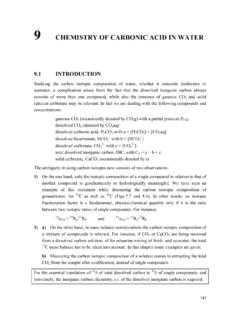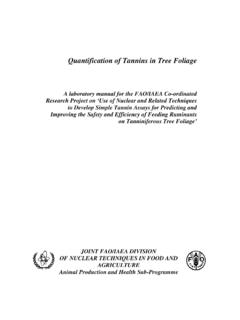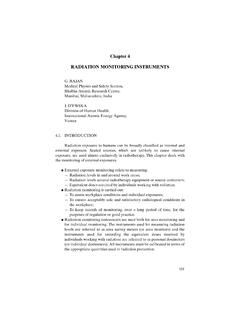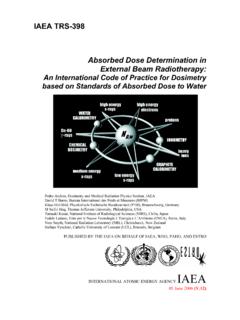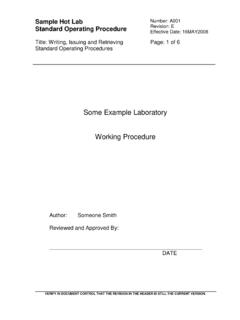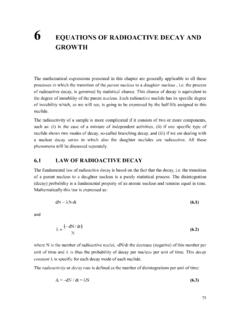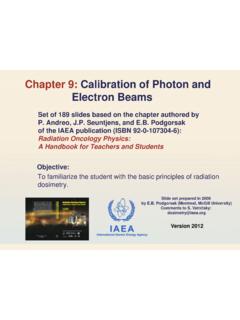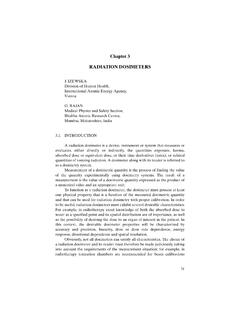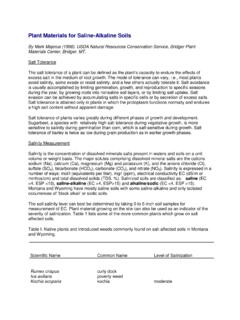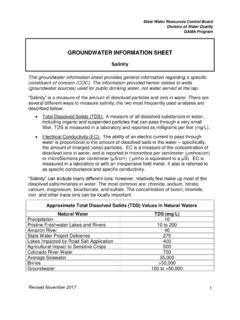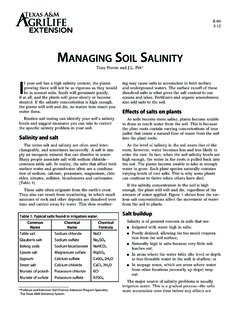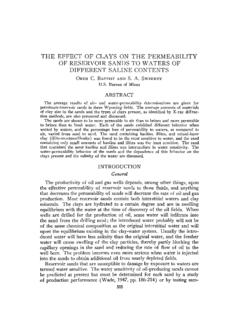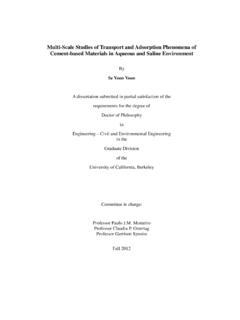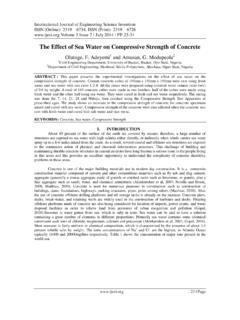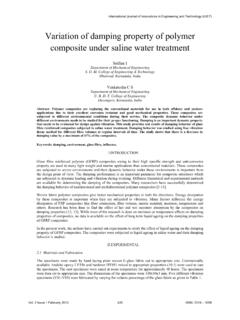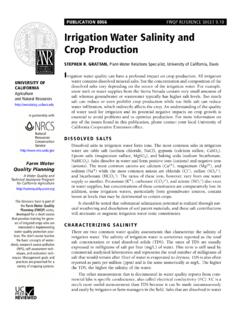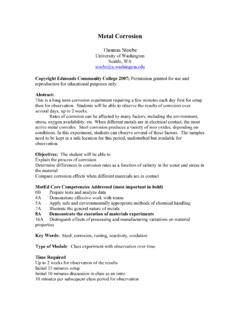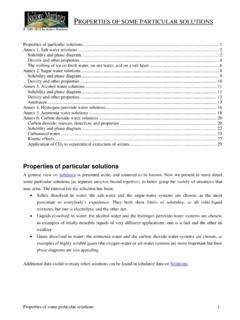Transcription of Origin of salinity and impacts on fresh groundwater ...
1 W. O. RK. IN. G. M. AT. E RI. AL. S. Origin of salinity and impacts on fresh groundwater resources: Optimisation of isotopic techniques Results of a 2000-2004 Coordinated Research Project Origin of salinity and impacts on fresh groundwater resources: Optimisation of isotopic techniques Results of a 2000-2004 Coordinated Research Project EDITORIAL NOTE. This publication has been prepared from the original material as submitted by the authors. The views expressed do not necessarily reflect those of the IAEA, the governments of the nominating Member States or the nominating organizations. The use of particular designations of countries or territories does not imply any judgement by the publisher, the IAEA, as to the legal status of such countries or territories, of their authorities and institutions or of the delimitation of their boundaries.
2 The mention of names of specific companies or products (whether or not indicated as registered) does not imply any intention to infringe proprietary rights, nor should it be construed as an endorsement or recommendation on the part of the IAEA. The authors are responsible for having obtained the necessary permission for the IAEA to reproduce, translate or use material from sources already protected by copyrights. CONTENTS. Summary 1. groundwater salinization in the South West Murray basin as a result of enhanced recharge .5. Leaney and Herczeg, Walker Origin of saline groundwater in the northeastern of Guanzhong Basin, China . 15. Dajun Qin Optimization of isotopic techniques to investigate groundwater salinization in Disi Basin, Jordan 29.
3 Amro, Kilani, Z. Al-Tarawneh, Moman and A. Subeh Environmental isotope-aided study for elucidating groundwater salinization on Cheju Island, Korea .45. Sung-Jun Song, Ki-Won Koh, Won-bae Park, Avner Vengos and Yoon-Suk Park Isotopic techniques as a tool to investigate salinization problems in the Souss Massa coastal plain (South West Morocco), Morocco ..61. L. Bouchaoua, M. Qurtobib, Y. Hsissoua, M. Ibn Majahb, H. Marahb Isotopic investigation of saline water intrusion and related impacts on potable water quality in the coastal aquifer of Karachi, Pakistan .. 81. A. Mashiatullah, R. M. Qureshi, T. Javed, M. A. Tasneem, M. Fazil, N. Ahmad, E. Ahma List of participants ..99. SUMMARY. ISOTOPE TECHNIQUES FOR CHARACTERIZING groundwater .
4 SALINIZATION. A Coordinated Research Project (CRP) on Origin of salinity and impacts on fresh groundwater resources: Optimisation of isotopic techniques was initiated in 2000 within the framework of the IAEA water Programme. Research groups from Australia, China, France, Israel, Italy, Jordan, Korea, Morocco, Pakistan, Sweden, Tunisia and United Kingdom of Great Britain participated in and contributed to the project. Two Research Co-ordination meetings were held in Vienna respectively in December 2000 and June 2003. The current publication is a compilation of final reports of six individual studies carried out under the CRP. The IAEA officer in charge of designing and coordinating all related work in this CRP and responsible for this publication was Cheikh B.
5 Gaye of the Division of Physical and Chemical Sciences. Salinization is a global environmental problem that affects various aspects of our life such as changing the chemical composition of natural water resources (lakes, rivers, and groundwater ), degrading the quality of agricultural and domestic water supplies, contributing to loss of biodiversity, loss of fertile soil, collapse of agricultural and fishery industries, and creating severe health problems ( , the Aral Basin). In Australia, for example, continuous soil salinization has become a massive environmental and economic disaster requiring drastic resource management changes. High levels of total or specific dissolved constituents associated with saline water other than sodium and chloride, may limit the use of the water for domestic, agriculture, and industrial applications.
6 For instance, in some parts of Africa, China, and India, high fluoride content is often associated with saline groundwater and causes severe dental and skeletal fluorosis. Consequently, the salinity problem is only the tip of the iceberg . High levels of salinity often associated with high concentrations of sodium, sulphate, boron, fluoride, and bio- accumulated elements such as selenium, and arsenic. High salinity groundwater may also be associated with high radioactivity. water salinization is a global problem but it is more severe in water -scarce areas, such as arid and semi-arid zones, where groundwater is the primary source of water . The increasing demand of groundwater has created tremendous pressure on the use of the resources resulting in lowering of water levels and an increase in salinization.
7 In the Middle East for example, salinity is the main factor limiting the continued use of groundwater , and future reliance on groundwater in the region is further diminished as groundwater levels decline, creating increases in salinity and in exploitation costs. The CRP participants have addressed the following categories of salinity problems: River salinization (River Murray, Australia, and River Souss, Morocco). Salinization due to damming and base flow in the arid zone (River Souss, Morocco). 1. Time of recharge/replenishment (Murray Basin, Australia, Disi aquifer, Jordan and Nubian sandstone aquifer, Israel). Time frames of salinization: past flushing versus modern mixing (Murray Basin, Australia, Disi aquifer, Jordan and Nubian sandstone aquifer, Israel).
8 Times scale of salt accumulation (Murray Basin, Australia). Identifying the extent of seawater intrusion (Karachi, Pakistan, Souss coastal plain, Morocco, and Cheju Island, South Korea). Distinction between present and past seawater intrusion and evolution of salinity (Karachi, Pakistan, Souss coastal plain, Morocco, and Cheju Island, South Korea). Leaching of evaporites (Souss coastal plain, Morocco, Guanzhong Basin, China, Nubian sandstone aquifer, Israel, and Disi aquifer, Jordan). Mixing with formation water and/or brines (Nubian sandstone aquifer, Israel and Guanzhong Basin, China). Modification and salinity build-up by water -rock interactions (Souss coastal plain, Morocco, Guanzhong Basin, China, Nubian sandstone aquifer, Israel, Disi aquifer, Jordan, Murray Bain, Australia, Cheju Island, South Korea, and Karachi, Pakistan).
9 Geothermal influence (demonstration study at Abano thermal basin, Italy and Cheju Island, South Korea). Urban environment sewage contamination (Karachi, Pakistan). Agricultural environment seepage of agricultural return flows (Souss coastal plain, Morocco, and Cheju Island, South Korea). Dry land salinization (Murray Basin, Australia, Nubian sandstone aquifer, Israel, Disi aquifer, Jordan, Souss coastal plain, Morocco, and Guanzhong Basin, China). Input salinity (all participants). The major objective of the CRP was to explore and develop isotopic tools that can be used to determine salinity sources and processes in aquifer systems. It was based on the implementation of several coordinated regional studies and a central flagship study in the Souss coastal aquifer of western Morocco.
10 The research sites represent a large variety of examples of the salinization problem. These include salt- water intrusion into coastal aquifers (Morocco, Pakistan, Cheju Island in South Korea), dry land and inland salinization (Australia, Jordan, Israel, China); salinization of fossil groundwater (Australia, Israel, Jordan), and anthropogenic salinization (Pakistan, Morocco). In addition to individual efforts of the different member countries to investigate the Origin of the salinization phenomena in their own country, special efforts were given to the integration of the isotopic techniques and cross- laboratories measurements. The integration approach enabled measurements of a large suite of isotopic tools in the selected research site in Morocco that include major and minor dissolved constituents, and the isotopic compositions of oxygen (18O/16O), hydrogen (2H/1H), 2.
